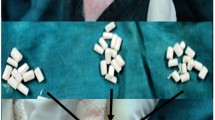Abstract
Bioactive glass granules of three different compositions, regarding particularly Si- and Al- content (S53P4, S59.7P2.5, S52P3) and of two different granule sizes (200–250 μm and 630–800 μm) were implanted for 4 and 8 weeks in the distal part of rabbit femur. The effect of glass composition and granule size on bone formation was studied. The results were evaluated using histology, computerized histomorphometry, scanning electron microscopy and energy dispersive X-ray analysis, and used for mathematical description of bone formation. The results showed that both the composition of the glass and the granule size of the granules, have influence on bone growth from the surrounding tissue. Glass S53P4, which from previous observations is known to be an effective bioactive glass and widely used in the Biomaterial Project of Turku, Finland, showed bone bonding and increasing bone growth between the granules. Glass S59.7P2.5 which due to its high Si-content should be inert, showed bone bonding. At 4 weeks the bone growth was significantly more abundant in bone defects filled with large granules (630–800 μm) than in defects filled with small granules (200–250 μm). Glass S52P3 with an alumina content of 3 wt %, showed good bone conduction, possibly even bone bonding for granules of 630-800 μm size. Granules of 200–250 μm with a high alumina content at the surface of the reaction layer, showed hardly any bone contact at all. This data, therefore, gives new information concerning bone bonding and osteoconduction of bioactive glasses with a high silica or alumina content.
Similar content being viewed by others
References
L. L. Hench and H. A. Pashall, J. Biomed. Mat. Res. 4 (1973) 25.
L. L. Hench, J. Am. Ceram. Soc. 74 (1991) 1487.
A. M. Gatti, T. Yamamuro, L. L. Hench and O. H. Andersson, Cells and Materials 3 (1993) 283.
O. H. Andersson and I. Kangasniemi, J. Biomed. Mat. Res. 25 (1991) 1019.
M. Jarcho, Clin. Orthop. Rel. Res. 157 (1981) 259.
M. Neo, T. Nakamura, C. Ohtsuki, T. Kokubo and T. Yamamuro, J. Biomed. Mat. Res. 27 (1993) 999.
L. L. Hench, Ann. NY Ac. Sci. 523 (1988) 54.
A. M. Gatti, G. Valdre and O. H. Andersson, Biomaterials 15 (1994) 208.
O. H. Andersson, K. H. Karlsson, K. Kangasniemi and A. Yli-Urpo, Glastech. Ber. 61 (1988) 300.
J. Ahlback, Experimental design. Lecture notes in Swedish, \0Abo Akademi University (1995).
D. M. Himmelblau. Process analysis by statistical methods (New York, Whiley 8 1970) p. 1.
K. Donath, EXAKT-Kulzer-Publication, Norstedt (1990).
N. Lindfors and A. J. Aho. Eur. Spine J. 9 (2000) 30.
T. Turunen, J. Peltola, R.-P. Happonen and A. Yli-Urpo. J. Mater. Sci.: Mat. Med. 6 (1995) 639.
H. Oonishi, S. Kushitani, H. Iwaki, K. Saka, H. Ono, A. Tamura, T. Sugihara, L. L. Hench, J. Wilson and E. Tsuji, Comparative bone formation in several kinds of bioceramic granules. Bioceramics Vol. 8, edited by J. Wilson, L. L. Hench and D. Greenspan (Elsevier Science Ltd., Oxford, 1995) p. 137.
S. A. Bergman and L. J. Litkowski, Bone in-filling of non-healing calvarian defects using particulate Bioglass and autogenous bone. Bioceramics Vol 8, edited by J. Wilson, L. L. Hench and D. Greenspan (Elsevier Science Ltd., Oxford, 1995) p. 17.
A. M. Gatti, O. H. Andersson, G. Valdre, L. Chiarini, D. Tanza, S. Bulgarelli and E. Monari, Mat. Clin. Appl. (1995) 409.
A. M. Gatti and D. Zaffe, Biomaterials 10 (1990) 245.
A. M. Gatti and D. Zaffe, ibid. 12 (1991) 497.
M. Peltola, J. Suonp, K. Aitasalo, H. Manen, O. Andersson, A. Yli-Urpo and P. Laippala, Acta Otolar Suppl. 53 (2000) 167.
O. H. Andersson, K. P. Yrjas and K. H. Karlsson, Reactions in and at the surface of bioactive glasses in aqueous solutions. Bioceramics Vol 4, edited by W. Bonfield, G. W. Hastings and K. E. Tanner (Butterworth-Heinemann Ltd, 1991) p. 127.
O. H. Andersson, L. Guizhi, K. H. Karlsson, L. Niemi, J. Miettinen and J. Juhanoja, J. Mater. Sci.: Mater. in Med. 1 (1990) 219.
U. Gross and V. Strunz, J. Biomed. Mater. Res. 19 (1985) 251.
O. Andersson, The bioactivity of silicate glass. Doctoral Thesis, Department of Chemical Engineering, \0Abo Akademi University, Turku, Finland (1990).
O. H. Andersson, A. J. Aho, K. H. Karlsson and A. Yli-Urpo. Bioceramics 6 (1993) 289.
O. H. Andersson, G. Liu, K. H. Karlsson, L. Niemi, J. Miettinen and J. Juhanoja, J. Mater. Sci.: Mater. in Med. 1 (1990a) 219.
Author information
Authors and Affiliations
Rights and permissions
About this article
Cite this article
Lindfors, N.C., Aho, A.J. Granule size and composition of bioactive glasses affect osteoconduction in rabbit. Journal of Materials Science: Materials in Medicine 14, 365–372 (2003). https://doi.org/10.1023/A:1022988117526
Issue Date:
DOI: https://doi.org/10.1023/A:1022988117526




